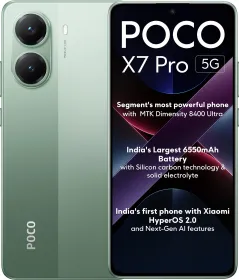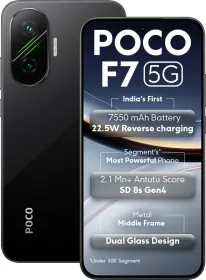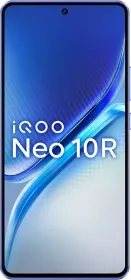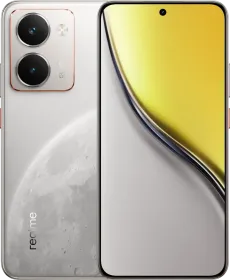The Chinese smartphone manufacturer iQOO just released a new mid-ranger, the iQOO Neo 10R. With the Snapdragon 8s Gen 3 chipset and a massive 6,400 mAh battery, the handset makes up for an easy recommendation under Rs. 30,000. But what about the Poco X7 Pro, another performance-oriented smartphone that is available at a similar price?
Let’s find out how the iQOO and Poco handsets compare to each other.
iQOO Neo 10R vs. Poco X7 Pro: Tech Specs
| iQOO Neo 10R | Poco X7 Pro | |
| Dimensions | 163.7 x 75.9 x 8 mm | 160.8 x 75.2 x 8.3 mm (or 8.43 mm PU) |
| Weight | 196 grams | 195 or 198 grams |
| Color | Raging Blue, MoonKnight Titanium | Black, Green, Yellow |
| IP Rating | IP65 | IP68 |
| Display | 6.78-inch 1.5K OLED panel (10-bit) | 6.67-inch 1.5K AMOLED screen (10-bit + 2-bit FRC) |
| Processor | Snapdragon 8s Gen 3 (4nm) | Dimensity 8400 Ultra (4nm) |
| Software | Funtouch OS 15 | HyperOS 2.0 |
| Camera | Rear: 50MP + 8MP Front: 32MP | Rear: 50MP + 8MP Front: 20MP |
| Battery Capacity | 6,400 mAh Si/C battery | 6,550 mAh Si/C battery |
| Charging Speed | 80W | 90W |
iQOO Neo 10R vs. Poco X7 Pro: Design
Materials

Both the phones have a plastic frame and back. While the iQOO Neo 10R features Schott Sensation Up glass in the front, the Poco X7 Pro features Gorilla Glass 7i protection.
In its yellow finish, the Poco X7 Pro sports a vegan leather back panel, giving it a premium in-hand feel.
Dimensions
- iQOO Neo 10R: 163.7 x 75.9 x 8 mm; 196 grams
- Poco X7 Pro: 160.8 x 75.2 x 8.3 mm plastic (8.43 mm PU); 195 grams (plastic), 198 grams (PU)
Between the two, the iQOO Neo 10R is the slimmer phone.
Design

Both phones feature a punch-hole front with thin bezels (slightly thicker bottom chin on the Neo 10R). On the back, the iQOO Neo 10R houses a square-shaped camera module (with rounded corners), while the Poco X7 Pro features two camera lenses (stacked vertically) on a module that protrudes from the back panel.
Colors
- iQOO Neo 10R: Raging Blue, MoonKnight Titanium
- Poco X7 Pro: Black, Green, Yellow
IP Rating
Regarding water resistance, the iQOO Neo 10R features an IP65 dust and water resistance rating, so it can only withstand low-pressure water jets or splashes. On the other hand, the Poco X7 Pro gets an IP68 rating (IP69 on the global units), which protects the phone for up to 30 minutes in 1.5m of water.
iQOO Neo 10R vs. Poco X7 Pro: Display

The iQOO Neo 10R offers a 6.78-inch 1.5K OLED panel (10-bit) with a resolution of 2800 x 1260 pixels (452 ppi) and an HBM brightness of 1200 nits. There’s support for up to 4500 nits of peak brightness, but that’s only applicable to a small portion of the screen (also referred to as local peak brightness).
Regarding refresh rate, the phone gets a 144Hz panel (up to 300Hz touch sampling rate). The handset also supports 3840Hz PWM dimming, which makes it comfortable for the eyes.

In contrast, the Poco X7 Pro has a slightly smaller 6.67-inch 1.5K AMOLED screen (10-bit + 2-bit FRC) with a resolution of 2712 x 1220 pixels (446 ppi) and an HBM brightness of 1400 nits (local peak brightness of 3200 nits).
Although the global refresh rate (120Hz) is lesser than that of the iQOO Neo 10R, the Poco X7 Pro has a touch sampling rate of 480Hz. The phone also supports 1920Hz PWM dimming.
While the iQOO Neo 10R supports HDR10+, the Poco X7 Pro also supports Dolby Vision content, making it the better device for streaming content via OTT platforms. Last but not least, both phones offer an under-display fingerprint scanner.
iQOO Neo 10R vs. Poco X7 Pro: Processor

Under the hood, the iQOO Neo 10R runs on the Snapdragon 8s Gen 3 (4nm) SoC, which features one 3.0GHz prime core, four 2.8GHz performance cores, and three 2.0GHz efficiency cores. With the Adreno 735 GPU, up to 12GB of LPDDR5X RAM, and up to 256GB of UFS 4.1 storage (UFS 3.1 on the 128GB variant), the phone offers great performance for both everyday tasks and mobile gaming.
In our tests, the iQOO Neo 10R achieved 1871/4678 points in the single/multi-core GeekBench 6 CPU score. On the AnTuTu 10 benchmark, the handset scored 1.3 million points, which is pretty good. However, its sequential read/write speeds were lower than what we usually get from UFS 4.0 devices. Lastly, the device supports 90 FPS in BGMI (with support for 120 FPS coming on March 13, 2025).

In contrast, the Poco X7 Pro runs on the Dimensity 8400 Ultra (4nm) chipset with one 3.25GHz prime core, three 3.0GHz performance cores, and four 2.1GHz efficient cores. With the Mali-G720 MC7 GPU, up to 12GB of LPDDR5X RAM. 256GB of UFS 4.0 storage, the Poco X7 Pro also knocks the doors of flagship performance.
What’s interesting is that the Poco X7 Pro scores higher than the iQOO Neo 10R in the Geekbench 6 CPU performance test – around 1550/6250 points in the single/multi-core performance test. AnTuTu 10 is a similar story, with the phone scoring around 1.5 million points. Based on reports, the phone peaks at around 70 fps on the popular battle royale video game BGMI.
Staple tasks like switching between apps, browsing through the internet, watching videos, or clicking pictures shouldn’t be a problem on either of the devices. Users shouldn’t have any issues running video games from medium to higher graphic settings either. But even so, we can’t help but notice that benchmark scores favor the Poco X7 Pro in the performance department.
iQOO Neo 10R vs. Poco X7 Pro: Operating System

Out of the box, the iQOO Neo 10R runs on Funtouch OS 15 (based on Android 15). The operating system offers plenty of useful features, like lock screen customization, multi-window support, and AI capabilities like AI Eraser, Super Document, Image Cutout, and AI Notes. Google’s Circle to Search is also a part of iQOO Neo 10R’s arsenal. Regarding software support, the company has promised to provide three/four years of OS/security updates.

The Poco X7 Pro boots HyperOS 2.0, which is also based on Android 15. Designed to improve performance and increase efficiency, HyperOS 2.0 offers refined visuals, a depth effect for the lock screen, new widgets, and a handful of GenAI features, including AI text-processing tools, an AI background eraser, AI Notes, and an AI Interpreter. Finally, the company has committed to providing three/four years of OS/security updates.
Given that both the phones came out in 2025, they stand right next to each other with similar software support. Hence, this comparison aspect comes down to personal preference between Funtouch OS 15 and HyperOS 2.0.
iQOO Neo 10R vs. Poco X7 Pro: Cameras
iQOO Neo 10R Camera Configuration

- Primary Camera: 50MP (f/1.79, OIS) Sony IMX882 sensor with autofocus
- Secondary Camera: 8MP (f/2.2) ultrawide sensor with fixed focus
- Front Camera: 32MP (f/2.45) sensor
The primary camera can record 4K60 videos, capture portrait pictures, provide 2x in-sensor crop, and let you capture live photos.
Poco X7 Pro Camera Configuration

- Primary Camera: 50MP (f/1.5, OIS) Sony IMX882 sensor with autofocus
- Secondary Camera: 8MP (f/2.2) ultrawide sensor with fixed focus
- Front Camera: 20MP (f/2.2) sensor
Like the Neo 10R, the X7 Pro can also record 4K60 videos, provides several shooting modes like portrait and night, and lets you capture live photos. Some additional features include a director mode for capturing videos, along with a Shoot Steady mode for capturing stable footage.
iQOO Neo 10R vs. Poco X7 Pro: Battery Life And Charging Speed

iQOO’s latest midranger features one of the largest batteries in the segment. The 6,400 mAh cell supports 80W wired charging. Fortunately, iQOO isn’t among the companies that don’t provide a charger in the box, i.e., you get an 80W power brick in the box.
The Poco X7 Pro doesn’t fall short either. It features a 6,550 mAh battery that supports 90W wired charging, capable of charging the phone in about 40 minutes. Like iQOO, Poco also offers a fast 90W charger in the box.
With regards to battery life, there should be a tie between both smartphones.
iQOO Neo 10R vs. Poco X7 Pro: Connectivity

Connectivity options on the iQOO Neo 10R include 5G, Wi-Fi 6, Bluetooth v5.4, GPS, IR Blaster, and a USB Type-C 2.0 port.
The Poco X7 Pro provides similar connectivity options, including 5G, Wi-Fi 6, Bluetooth v5.4, GPS, NFC, IR Blaster, and a USB Type-C 2.0 port.
iQOO Neo 10R vs. Poco X7 Pro: Price And Conclusion
iQOO Neo 10R Price

- iQOO Neo 10R (8GB + 128GB): Rs. 26,999
- iQOO Neo 10R (8GB + 256GB): Rs. 28,999
- iQOO Neo 10R (12GB + 256GB): Rs. 30,999
The reasons to consider the iQOO Neo 10R include a higher refresh rate screen, excellent performance (especially the 120 fps on BGMI), a massive silicon carbon battery, and a minimal design.
Interested buyers can also get a Rs. 2,000 instant discount using SBI, ICICI, and HDFC bank cards, reducing the effective price of the smartphone. The phone will be available on sale beginning March 19, 2025.
Poco X7 Pro Price

The Poco X7 Pro is also a compelling device. With bank offers, you can get the baseline variant for Rs. 24,999, which is a decent price. If raw performance is a priority, you can go with the Poco X7 Pro. Users with some experience with MIUI or HyperOS should also feel comfortable navigating through the X7 Pro’s UI.
You can follow Smartprix on Twitter, Facebook, Instagram, and Google News. Visit smartprix.com for the latest tech and auto news, reviews, and guides.

































